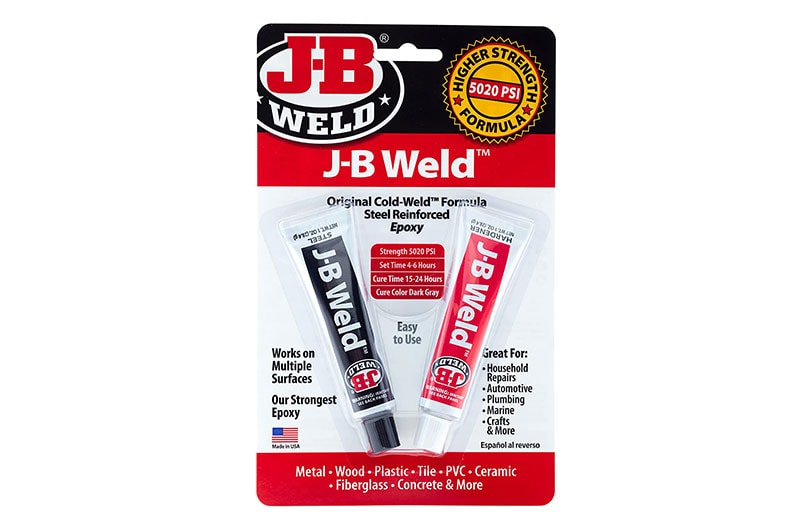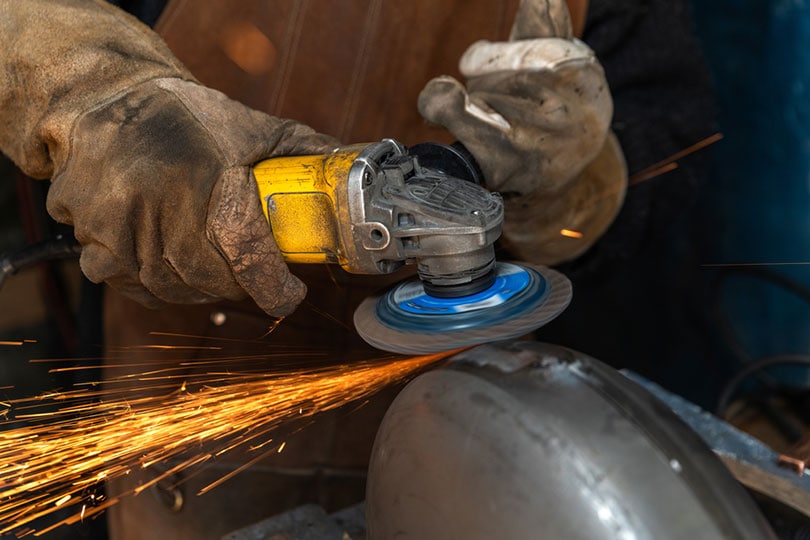Can You Sand JB Weld? Is JB Weld Sandable?
Last Updated on

J-B Weld is a two-part epoxy that can be used to bond metal, glass, ceramic, and plastic. It’s often used in automotive and plumbing applications because it forms a strong waterproof bond. After using a J-B Weld, you may be left with some residue on the surface of the repaired area from the adhesive itself or other imperfections on the surface. You can sand it once it has cured (fully set) to smoothen the surface and create a better finish.
However, it’s important to use the right type of sandpaper so you don’t damage the surface you’re working on. Use fine-grit sandpaper for best results.
In this article, we will take an all-around look at sanding J-B Weld, how to make clean and smooth repairs, the pros and cons, and how to go about the whole process of sanding J-B Weld.
Sanding…What Is It Exactly?
To understand sanding a J-B Weld, we need to know what sanding is. This is the process of smoothing a surface by rubbing it with sandpaper. There are several types of sandpapers, each designed for a specific purpose. Some are meant for metalworking, woodworking, and stripping paint or varnish, meaning you should always ensure you have the right sandpaper for the job.
Bigger sanding tasks may require power tools to help with the sanding process, while smaller tasks can be accomplished manually by hand.

Sanding J-B Weld
J-B Weld is a sandable adhesive, but it needs to dry first before you can sand it. The adhesive is quite hard and rubbery, making it a bit of a challenge to sand.
The wet sanding method with waterproof abrasive paper is the best technique for sanding J-B Weld. Waterproof sanding simply uses a lubricant such as water or other liquids, including detergent to remove the grit particles. It prevents clogging and the accumulation of dust on the sandpaper.
You may want to avoid palm sanders because they produce heat during the process, which may soften the adhesive and clog the paper quickly.
Waterproof sandpaper is made up of silicon carbide and is available in a variety of sizes from 60 to 1,000 grit. For J-B sanding, you need waterproof sandpaper with 1,000 grit. One of the disadvantages of this kind of sandpaper, though, is that you have to use your hands for the job as any kind of electronic tool may create an electric shock.
However, you can use an air-powered sander for huge surfaces. Additional options like disk sanders are recommended for softer surfaces, such as wood or plastic. For metal parts, you can use the belt or orbit sanding papers.
It is worth noting that the wet sanding method will not work on all surfaces, meaning you should have prior knowledge of what surface to apply which kind of sanding.
Different Surface and the Best Kind of Sanding Method
Generally, the choice of sanding method will depend on the sensitivity to moisture. For surfaces that are not sensitive to moisture, wet sanding will take priority due to the obvious advantages of the method. For the more moisture-sensitive surfaces, dry sanding is the best way to go.
For wooden surfaces, wet sanding may have a negative impact as it will result in swells and staining of the wooden surface.
https://www.instagram.com/p/CffOuB3uO7r/
Sanding J-B Weld Clear Epoxy
Clear epoxy is a polymer used in the coating of several surfaces, including wood, veneer, metal, stone, painted surfaces, tabletops, bar tops, and a lot more. The effect of this is a glossy look that helps protect surfaces from humidity and scratches.
It is possible to sand a clear epoxy after it has already formed a permanent bond. After the curing process is done, you can also shape, drill, and even paint the surface.
In case you want to sand the J-B clear epoxy, you have to clean the parts you are looking to repair with a detergent or degreaser.
Use sandpaper to make the surface rough to allow the J-B Weld epoxy to bond to the surface. Basically, you first make the surface rough with sandpaper and then wipe it clean.
Sanding J-B Weld Steel Stick
J-B Weld stick is a hand mixable epoxy that comes with two parts; it is steel reinforced and non-rusting.
It is possible to sand J-B Weld a steel stick, but only after hardening. You can also grind or drill it just as you would do on concrete or steel. The steel stick will need around 3-60 minutes, after which you can drill, grind, or tap it.
The J-B steel stick has a dark gray color after curing with the potential of reaching up to 900 psi.
https://www.instagram.com/p/CaTFpW0rFFO/
Pros and Cons of J-B Sanding
- One of the main advantages of J-B sanding is that it is an inexpensive way of making repairs to your damaged parts compared to almost all other welding methods.
- J-B sanding is also chemical-free; it means no risk to your health by exposure to unnatural chemicals
- It also helps reduce imperfections on your damaged parts by removing adhesive residues on your repaired surface
- If you use the wrong kind of sanding method on a surface, you may end up with damage; the adhesive can melt, resulting in weaker bonds
- There are also other problems like exposing yourself to wood dust, which may have some negative effects on your health
- Sanding takes a lot of time, especially if you are doing it manually by hand
Alternatives to J-B Sanding
You may be caught in a scenario where you do not have access to the abrasive to work on your J-B Weld. You still have other alternatives to help work on your J-B Weld including:
Heat
In the absence of sandpaper for your J-B Weld, heat is one of the best alternatives. It is also an effective way to work on imperfections created after welding metal and heat-resistant surfaces.
You can use a heat gun to change the J-B Welds’ chemical structure, which helps you scrape away quicker.
In the absence of heat, steam is another great way to soften the J-B weld. You will need to put some hot water into a pot and put the welded part over the pot, letting the steam run over it for 30 minutes to one hour.
Remove the part and scrap off the unwanted parts with some tongs until you achieve a smooth finish.
Chemicals
You can also use chemicals such as white vinegar, acetone, and ethanol to achieve the desired finish. For the chemicals to work, the J-B Weld should not be fully dry.
To go about this, soak a rag into the chemical of your choice and cover the area with the adhesive. Afterward, wipe away the undesired residue.
Final Thoughts
The versatility of the J-B technique and the number of materials it can be used on, including plumbing, ceramic, catalytic converters, exhaust pipes and glass, makes it an amazing product for use in welding compared to traditional torch welding.
It is also faster and can withstand high temperatures with the possibility of achieving a smooth finish that you cannot get on traditional welding.
The best part is that the J-B Weld can be sanded once it has cured. Use a fine-grit sandpaper for best results. Work with caution so that you don’t damage the underlying surface. If the J-B Weld is still wet, use wet/dry sandpaper.
Featured Image Credit: Amazon
